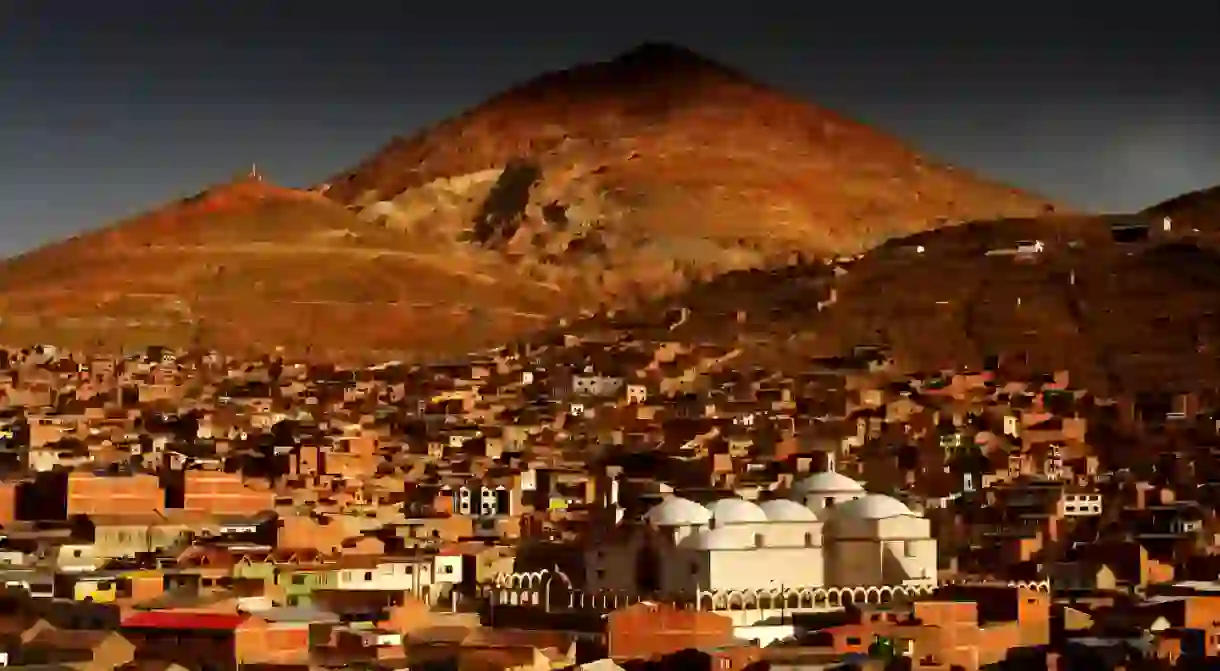A Brief History of Potosí and Cerro Rico

The highland colonial city of Potosí is best known for its underground mining tours, where miners eagerly accept gifts of alcohol and dynamite before allowing tourists in to see the appalling conditions of their deadly workplace. But what many dont know is that this city was once one of the largest and wealthiest urban areas in the world. It was the vast amounts of silver exploited from nearby Cerro Rico that funded the Spanish Empire on their mission to colonize the New World.
The Potosí region was originally inhabited by the indigenous Charcas and Chullpas people who lived in relative harmony, crafting wares from silver and clay to trade with neighboring ethnic groups. The Incas arrived in the 16th century and quickly conquered the natives through sheer military might, forcing them into a system of slavery, known as mit’a, to begin mining for silver. Legend has it that an Incan emperor had intended to ramp up mining in the region until he was instructed by a booming voice from deep under the surface to flee from the mines, warning him that the precious mineral was intended for “others.” The Inca named their city Ptojsi, which means “spring fourth” in Quecha, after the voice that sprang forth from the mountain that day.

The mountain’s prophecy came true as the Spanish arrived soon after and took control of the region and its mines. Having learnt that the area was rich in silver, they adopted the mit’a system and forced the Inca and other remaining natives into a life of slavery. Over time, the slaves began to die off from overexertion and exposure to harmful underground gases. The Spanish compensated by importing some 3,000 African slaves per year to replace them. An estimated 30,000 slaves in total were brought in, with the survivors later migrating to warmer parts of the country to form what is now known as the Afro-Boliviano community.

At its peak in the 17th century, Potosí (a Spanish mispronunciation of the Quecha word “Ptojsi”) was one of the largest cities in the world. Some 200,000 people called it home, which was more than London at the time. The population was a mishmash of slaves, miners, traders, noblemen and aristocrats, among others, almost all of whom were there to directly or indirectly support the world’s largest industrial complex. The silver mined from Cerro Rico constituted 60 per cent of the world’s entire supply, such an abundance that some streets were said to have been paved with silver bars. This gave rise to the Spanish expression, “vale un potosí” – to be worth as much as Potosí – which is still in use today. A number of grandiose colonial structures were erected in the otherwise haphazard city, the most significant of which was the Casa de Moneda (royal mint).

The first Casa de Moneda was built in the 16th century in order to smelt exploited silver into bars and coins before being shipped off to Spain. As mining grew in the region, the building couldn’t keep up with demand, so a larger mint was constructed in the 18th century. The new mint, which still stands today, is absolutely huge, spanning 160,000 square feet (15,000 square meters) and featuring over 200 rooms. Upon completion, it was considered the most important building of the Spanish New World Empire.

But Spain’s grip on the New World was not to last forever. A 15-year war for independence saw Potosí change hands between Royalist and Independence forces on several occasions. The war finally ended in 1825 as independence was declared, though Potosí was left in shambles. All of its riches had been shipped off to Spain and mass migration saw its population dwindle to just 9,000 residents. An increase in the value of tin, which is also plentiful in Cerro Rico, saw a brief economic improvement, but this was shattered by Bolivia’s defeat in the War of the Pacific when the country lost its coastline and means of efficient exportation. The later Chaco War was equally disastrous, causing many Potosínos to lose their lives as they marched off to fight to their deaths in the unforgiving desert.

Despite continuous mining of the last deposits of wealth from Cerro Rico, Potosí has gone from having streets paved with silver to being one of the poorest major cities in Bolivia. According to Eduardo Galeano, Uruguayan journalist and author of Open Veins of Latin America, some six million people have died from mining Cerro Rico throughout its history. Frustratingly, almost all of this wealth ended up in the hands of the Spanish, leaving Bolivia with very little to show for it. What’s more, Cerro Rico is soon predicted to collapse, which will further devastate the city’s fragile economy.













